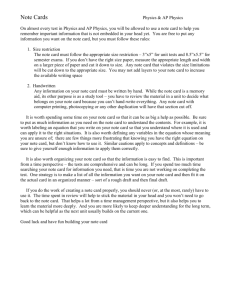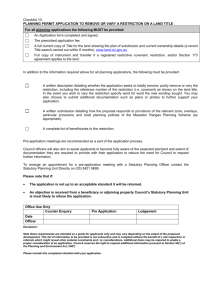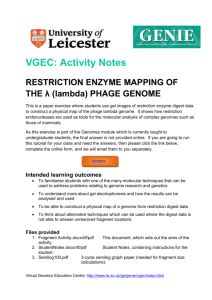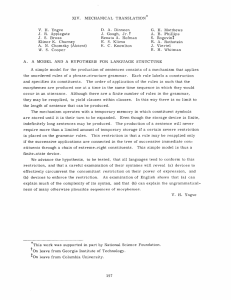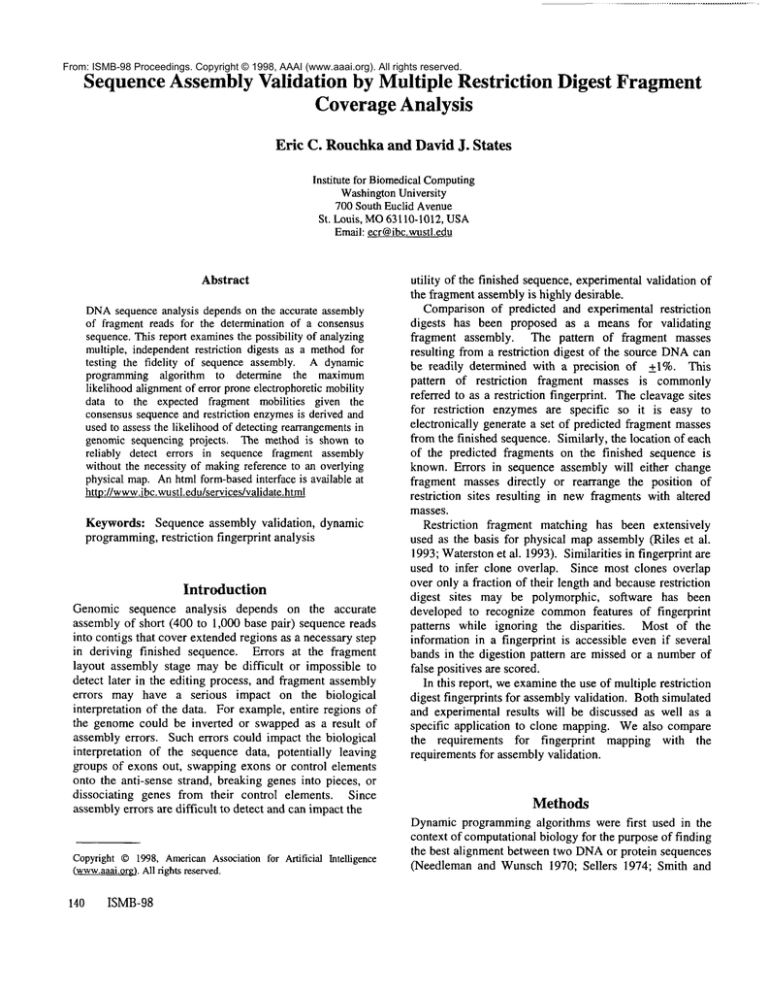
From: ISMB-98 Proceedings. Copyright © 1998, AAAI (www.aaai.org). All rights reserved.
Sequence Assembly Validation by Multiple Restriction
Coverage Analysis
Digest Fragment
Eric C. Rouchkaand David J. States
Institute for BiomedicalComputing
WashingtonUniversity
700 South Euclid Avenue
St. Louis, MO63110-1012,USA
Email: ecr@ibc.wustl.edu
Abstract
DNA
sequence analysis dependson the accurate assembly
of fragment reads for the determination of a consensus
sequence.This report examinesthe possibility of analyzing
multiple, independentrestriction digests as a methodfor
testing the fidelity of sequence assembly. A dynamic
programming algorithm to determine the maximum
likelihoodalignmentof error proneelectrophoreticmobility
data to the expected fragment mobilities given the
consensussequenceand restriction enzymesis derived and
usedto assess the likelihoodof detecting rearrangements
in
genomicsequencing projects. The methodis shownto
reliably detect errors in sequence fragment assembly
without the necessity of makingreference to an overlying
physical map.Anhtml form-basedinterface is available at
http://www.ibc.wu
stl.edu/services/validate.html
Keywords: Sequence assembly validation, dynamic
programming,restriction fingerprint analysis
Introduction
Genomic sequence analysis depends on the accurate
assembly of short (400 to 1,000 base pair) sequence reads
into contigs that cover extendedregions as a necessary step
in deriving finished sequence. Errors at the fragment
layout assembly stage maybe difficult or impossible to
detect later in the editing process, and fragment assembly
errors may have a serious impact on the biological
interpretation of the data. For example, entire regions of
the genome could be inverted or swappedas a result of
assembly errors. Such errors could impact the biological
interpretation of the sequence data, potentially leaving
groups of exons out, swapping exons or control elements
onto the anti-sense strand, breaking genes into pieces, or
dissociating genes from their control elements. Since
assemblyerrors are difficult to detect and can impactthe
Copyright©1998,American
Associationfor Artificial Intelligence
(Www.aaai.0rg).
Allfightsreserved.
140
ISMB-98
utility of the finished sequence, experimentalvalidation of
the fragmentassemblyis highly desirable.
Comparisonof predicted and experimental restriction
digests has been proposed as a means for validating
fragment assembly. The pattern of fragment masses
resulting from a restriction digest of the source DNA
can
be readily determined with a precision of +1%. This
pattern of restriction
fragment masses is commonly
referred to as a restriction fingerprint. Thecleavage sites
for restriction enzymes are specific so it is easy to
electronically generate a set of predicted fragment masses
from the finished sequence. Similarly, the location of each
of the predicted fragments on the finished sequence is
known. Errors in sequence assembly will either change
fragment masses directly or rearrange the position of
restriction sites resulting in new fragments with altered
masses.
Restriction fragment matching has been extensively
used as the basis for physical mapassembly(Riles et al.
1993;Waterstonet al. 1993). Similarities in fingerprint are
used to infer clone overlap. Since most clones overlap
over only a fraction of their length and because restriction
digest sites may be polymorphic, software has been
developed to recognize commonfeatures of fingerprint
patterns while ignoring the disparities.
Most of the
information in a fingerprint is accessible even if several
bands in the digestion pattern are missed or a numberof
false positives are scored.
In this report, we examinethe use of multiple restriction
digest fingerprints for assemblyvalidation. Both simulated
and experimental results will be discussed as well as a
specific application to clone mapping. Wealso compare
the requirements for fingerprint
mapping with the
requirements for assemblyvalidation.
Methods
Dynamicprogrammingalgorithms were first used in the
context of computationalbiology for the purpose of finding
the best alignment between two DNAor protein sequences
(Needleman and Wunsch1970; Sellers 1974; Smith and
Waterman 1981). We have developed a similar dynamic
programming algorithm to determine the maximum
alignment of error prone electrophoretic mobility data to
predicted fragment mobilities. The expected fragment
mobility information can be calculated whenthe sequence
to validate and the restriction enzymepatterns used in
creating the experimental data are known.String matching
functions are used to find the exact location of a particular
cutting site in the sequence. Predicted fragments are
generated according to these locations. The mobility, m,
for each of these expected fragmentsis calculated using the
same formula from which the experimental data is derived:
m fragment---
2Log
tfragmereIj
whereLtot is the total length of the sequencingproject. The
factor of 2 is applied to give mobilities in the range typical
of current experimental protocols, 0 to 20 cm. In these
units, a standard deviation in determination of band
position of 0.1 cm corresponds to a relative accuracy of
mass determination of 0.5%.
Within the dynamicprogrammingalgorithm, fingerprint
pattern alignments were scored using a log odds system
based on the likelihood of deriving the observed fragment
mobilities from the predicted digest mobilities relative to
the odds of observing the fingerprint pattern at random.
Relationship
Score
Band match
Log(Pmatch]Prandom)
False positive
Log(Praise
positive)
False negative
Log(Pf~¢.~ativ~)
Theprobability, Pmatch, of a fragment having an
observed mobility, mobs, given a true mobility, m, and
normally distributed errors in mobility determination
(Druryet al. 1990, 1992),
("
Pmatch (mobs I m)
1
~/2~O"e
Prandom
~
N
X
The values of Praise positive (false positive "added"band
probability), P/~tse negative (false negative "missing" band
probability), and o" (standard deviation fromtrue mobility)
are calculated based on the precision with which the
experimental data can be extracted.
This scoring system penalizes either matching a band
with an error in the mobility or failing to match a band
altogether. The false positive score represents the case
where a band in the experimental data does not match up
with a band in the expected data. The false negative score
represents the case where a band in the expected data does
not match up with any experimental bands.
The
maximumscore is the log likelihood that the query
fingerprint was derived from the target pattern under the
assumptions of our model relative to the likelihood of
assuming the same match at random. Scores are reported
in units of the natural logarithm of the likelihood ratio
(nats). Theymaybe converted to bits by dividing In(2).
Coverage
Since the sequence to be validated is known,a mapof the
restriction enzymecut sites can be created for each of the
restriction enzymesused in the experiments. As a result,
the location of each of the expected fragments within the
sequence is known. Figure 1 shows an example of the
knowncutting sites for the restriction enzymesBamH/,
EcoRI, HindlII, and KpnI within an examplesequence.
For each of the four restriction
enzymes, an
experimental digest has been performedindependent of the
other 3 enzymes. The experimental fragments are
comparedto the expected fragments using the previously
described dynamic programming algorithm. The purpose
of the algorithm is to tell whichof the expected fragments
are matchedwith an experimental fragment. A region
(mobs - m)
22¢r
Assumingthat the fragmentmobilities scale as the log of
the molecular weight of the fragment (Maniatis et al.
1975), this formulationresults in a constant fractional error
in mass determination
and agrees with empirical
observations based on current data (M. Marra, personal
communication).
The probability, Pr,,~om, of matching a band at random
given a maximum
mobility of X and N bands is:
Figure 1. The sequences labeled BamHl,EcoRI, HindlII and
KpnIshowthe location of the respective restriction enzyme
recognition sites within an examplesequence. The sequence
labeled TOTAL
indicates the location of all of the enzyme
restriction sites withinthe sequence.
Rouchka
141
between two restriction
sites in the sequence to be
validated is said to be covered whenit is matchedwith an
experimental fragment. The results of the coverage
analysis for each individual restriction enzymecan be
combined to produce a total coverage map where the
coverage for any particular fragment can range from 0%to
100%. Whenfour enzymes are used, the coverage for any
fragment between two restriction sites can be 0%(not
covered by any individual restriction enzymecoverage
map), 25%(covered by one), 50%(covered by two),
(covered by three), or 100%(covered by all four restriction
enzyme coverage maps).
Analysis of coverage maps can indicate possible
sequence assembly errors. For instance, suppose that one
segment within the clone has been reversed in the sequence
assembly¯ In such a case, we would expect two predicted
restriction fragments from each digest not to be matched,
resulting in a low coveragefor the regions containing these
fragments. The regions of low coverage contain within
them the endpoints of the reversed segment¯
Setting up the Simulations
Simulated restriction digest patterns were created by
adding random perturbations to the computationally
predicted mobilities. The predicted mobilities were created
using a subset of the palindromic 6 base restriction sites
EcoRI (GAATTC), BamHI (GGATCC), HindlII
(AAGCTT), Bali (TGGCCA), HpaI (GTI~AAC),
(CTGCAG), SalI (GTCGAC), KpnI (GGTACC),
(GCCGGC),and NarI (GGCGCC).The test fingerprints
were comparedwith reference fingerprint patterns derived
from sequences rearranged by introducing a segmental
inversion between two randomly chosen points in the
sequence¯ For each of the patterns, we find which target
bands get matched up with an experimental band. Using
this information, a coverage plot can be generated for the
target sequence¯ By comparingthe digest patterns of more
than one restriction enzymeand overlapping their coverage
results, it is proposedthat errors in sequence assemblycan
be differentiated from false positive and false negative
experimental bands. Weran simulations to test the effects
of false positive and false negative band rates (ranging
from .5% - 2%), band mobility resolution (ranging from
¯ 1%- 1%; 0.02mm- 0.2mm),and the numberof restriction
enzymes used. Welooked at false negative rates (the
percentage of time that one of the ends in the inversion is
not detected by coverageanalysis) and false positive rates
(the percentage of time that an incorrect inversion location
is detected by coverage analysis). The data presented is
based on the simulations using a 219.4 kb interval derived
from the human X chromosome (GenBank accession no.
L44140) (Chen et al. 1996). Wewill focus on the results
using 4 restriction enzymesfor a moredetailed discussion¯
142 ISMB-98
Experimental results have also been achieved using a
HindlII digest on the bWXD718
sequencing project at the
WashingtonUniversity Center for Genetics in Medicine¯
Theseresults are discussed as well.
Results
The Washington University Center for Genetics in
Medicine and Genome Sequencing Center have been
collaborating in construction of sequence ready mapsand
reagents for the human X chromosome, and over 1,000
clones have now been fingerprinted. The precision of
fragment mass determination was 1%(M. Marra personal
communication). In the early phases of this work 30
clones were sent for repeat analysis makingit possible to
estimate the reliability of the fingerprint data. In this
preliminary data set, one discrepancy in 25 bands was
observed between identical clones implying a combined
false positive and false negative rate of roughly 4%. As
the lab has become more experienced with fingerprint
analysis, performancehas improvedsubstantially.
Increasing the Numberof Restriction Enzymes
Figure 2 illustrates the use of a single restriction enzyme.
Fingerprint analysis is sensitive to false positive and false
negative bands. As a result, it can be impossible to
differentiate betweenfalse negative bands and regions of
incorrect sequenceassembly.A restriction site is expected
every 4 6 = 4096 bases in random sequence since 6 base
restriction
enzymes are used. It is well known that
genomes are not randomly distributed.
Thus, some
restriction sites might be rare in a particular region¯ Two
problemscan result¯ The first is that an inversion can be
missed because it has a greater likelihood of occurring
between two sites where it cannot be detected¯ The second
is that even though a region of low coverage might be
detectable, a greater area might have to be considered as a
possible location for the inversion.
A second enzyme can help alleviate the problem of
differentiating false negatives and areas of concern.
However, if the restriction
enzymes are not chosen
carefully, relatively long stretches where there is not a
restriction site for either enzymecan still exist. Figure 3
illustrates the results using a secondrestriction enzyme¯
Coverageanalysis of our simulations suggests that the use
of four or moreenzymesshould produce the desired results
(compareFigures 2, 3, and 4). Twoenzymesstill present
the difficulty of an inversion occurring in between two
restriction sites¯ Experimentalerrors will also have some
effect when only two enzymes are used. We have
analyzed the results using an even number of enzymes¯
This is done to balance the number of A+Trestriction
patterns with the numberof G+Crestriction patterns, so as
to avoid compositional biases¯ Figure 4 illustrates the
results using four restriction enzymes.If the restriction
digests are repeated whena potential region of difficulty is
observed, experimental gel errors can be filtered out and
differentiated from sequence assembly errors. Figure 5
illustrates this point. Note that if a single enzymeis used
(as in Figure 2), the digests would have to be repeated
quite often due to false negative bands.
Figure2: Coveragegraphusing one restriction enzyme.
Table I and Figure 6 examine the effects on the
percentage of time that a region of faithful sequence is
found to have low coverage by restriction digest fragment
mapping. Figure 7 shows the percentage of time that a
region that is involved in a segmentalinversion is found to
have high coverage. This corresponds to the fraction of the
time that the rearrangement would be missed by our
analysis.
Figure3: Coveragegraphusing two restriction enzymes.
CompleteDJ3e~Coverage
..°
6@
4@
Figure 4: Coveragegraphusing 4 enzymes.
Figure 5: Coveragegraphusing 4 enzymesand repeating the
digestanalysis.
Comp/ete
Digest
Coverage
Co.fete
Dige.st
Coverage
120
88
I
.............................
6O
i
48
cL 4~
.............................
2e
1
T
7--
4.’:;S~9
87"~78
13! 6~S
Hu~leO~
I dIPo~;
"I:I o~
I~
Fi~uures2-5: Coveragegraphs. Indicated in all four figures is the coveragefor the 219.4kb region with a segmentalinversionbetween
nucleotides136,796and 201,014.Asingle restriction enzyme
is usedin figure 2, resulting in four regions of zero coverage.Twoof these
are dueto experimentalfalse negativerates, suggestingthat a single enzyme
is not sufficient for sequenceassemblyvalidation. Whentwo
restriction enzymesare used as in figure 3, onlythe tworegions wherethe inversionoccurs havezero coverage,indicating that using a
secondrestriction enzyme
improvesthe analysis. Figures 4 and 5 showthe results using four enzymes.In figure 4, the bandaroundthe
segmentalinversionendpointshas shrunkto 2175nucleotidesfor the left endand 1161nucleotidesfor the right end. Figure5 repeats the
restriction digest. Somebands begin to have better coverageand the area surroundingthe left end has shrunk from 2175to 1286
nucleotides.
Rouchka
143
Gel
FalsePositive Result
False NegativeResult
Res.
.5%
1%
2%
.5%
1%
2%
0.001
4.2%
6.8%
9.9%
6.2%
3.8%
3.9%
0.0025
5.5%
7.5%
l 1.9% 6.1%
4.2%
5.8%
0.004
5.9%
7.2%
11.2%
2.8%
3.8%
6.3%
0.0055
4.9%
8.2%
12.6%
3%
4.9%
3%
0.007
7.5%
7.7%
13.2%
3.9%
4.6%
3.3%
0.0085
5.5%
7.2%
13.5%
5%
3.5%
5%
0.01
5.2%
8.5%
11.4%
4.3%
3.6%
6%
Table I: Empirical error rates for band assignment. The
table presents the error rates for the assignment of segmental
inversions to their corresponding segmentof genomicsequence.
Thecolumnon the far left represents experimentalgel resolution
values. False positives are the percentage of time that a region
not involved in a segmental inversion is found to have low
coverage. False negatives are the percentage of time that a
region that is involved in a segmental inversion is not found.
Within each section results are presented for simulations
conducted with false negative and false positive band calling
rates of 0.5%, 1%and 2%, and these results are presented
separately. These results are based on 4 enzymedigests, each
performed once, and a coverage cutoff of 50%.
COml~doon
of Misspositive/negative
sxpeclm~ntal
ralos
using
4 enzyme,,
(5O%
co.ragecuto~
Figure 6: False positive rates. This figure corresponds to the
data from Table I. The x-axis represents the standard deviation
from true mobility and the y-axis represents the false positive
rates. By examining this graph, we can see that the
experimental false positive and false negative rates have an
effect on false positives. In particular, as the experimentalrates
increase, so does the percentageof time that a region that is not
involved in a segmental inversion is found to have low
coverage. At the same time, the standard deviation from true
mobility does not seemto affect the false positive percentage.
Comparison
of false posltlve/negatlveexperimental
rates
using 4 enzymes
(SO%coverage
cutoff)
Analysis of Experimental Data
One of the sequencing projects
that the Washington
University Center for Genetics in Medicine and Genome
Sequencing Center is working on involves a region of the
human X chromosome
labeled
bWXD718. In a
preliminary assembly, the sequence appears to be 79,612
nucleotides long, The experimental HindlII digest of this
clone indicates
a total fragment size of 169,699
nucleotides, indicating the preliminary assembly contains
errors.
All but two of the expected fragments match up with
experimental fragments. The two fragments that do not
match up are 558 and 145 nucleotides long. It is possible
that some of the smaller fragments travel through the gel
more rapidly, and thus there are greater errors, so the 558
nucleotide segment might actually map to an expected
segment that is 520 nucleotides
long. Also, the 145
nucleotide segment might have gone undetected in the
gels. Thus, the validation program cannot discern where
the problem is located, but rather alerts the biologists that
there is an existing assembly problem or a molecular
biological
rearrangement
that occurred between the
fingerprint and sequence analysis stages.
144
ISMB-98
Figure 7: False negative rates. This figure corresponds to the
data from Table I. The x-axis represents the standard deviation
from true mobility and the y-axis represents the false negative
rates. By examining this graph, we can see that the
experimentalfalse positive and false negative rates do not have
muchof an effect on the rate of missing a rearrangement.
Discussion
The results presented here demonstrate that it is possible
to detect most sequence fragment assembly errors using a
set of four restriction digests and without reference to an
overlying physical map. The confidence of sequence
validation
can be further improved by independently
repeating the digests or by using additional enzymes (data
not shown). The confidence of sequence validation
improves with both the resolution of the electrophoretic
fragment sizing and the accuracy of band calling.
False Negatives
There are four reasons why the simulated segment
inversion sites may not be determined correctly. One
reason is that the inversion could occur in a segmentsuch
that it does not overlap any restriction sites. Another
explanation is that the inversion occurs in such a waythat
the restriction sites are located near the middle of the
inverted segment,resulting in similar fragmentmobilities.
Thirdly, an inversion occurs in such a way that the
modified segmentsare similar to other existing segments,
so coverageis preserved, albeit at a lower percentagethan
normal. Finally, the inversion could occur within a long
repeat segment,resulting in no change with an inversion.
Application to Clone Mapping
Weare currently collaborating with the Washington
University Center for Genetics in Medicine and Genome
Sequencing Center to use these assembly validation
techniques to map locations of BACand YACclones
within the human genome. For the purposes of our
analysis, we are given both the end sequences of the
clones and a set of restriction digest fragments for the
enzymes BamHI, EcoRI, HindlII, and KpnI. Once we
have the experimental data, the process begins by
searching GenBank for homologies with the end
sequences using a local sequence alignment technique.
Wefind which, if any, of the sequences in the database
have stretches of matching nucleotides longer than 30
nucleotides. Wetake the longest stretches and try to find
a contiguous sequence connecting the two ends. If such a
contiguous sequence exists, we can compare an expected
digest covering this region with the experimental digests.
A coverage graph of the results can then be analyzed.
Such a study can be helpful because it places the clones
within existing sequences, helping to determine whether
or not the whole clone should be sequenced. This might
help to bridge the gap between two segments. Wehave
gathered data for the bWXD1034and bWXD1035
sequencingprojects and are in the process of assimilating
the results.
Differences Between Physical Mappingand Assembly
Validation
Restriction digest fingerprinting has been an effective and
useful tool in physical mapassembly(Riles et al. 1993;
Waterston et al. 1993), but there are several critical
differences
between genome mapping and sequence
assembly validation. In physical mapping, the problemis
to identify overlappingclones by similarity in their digest
patterns. The presence of one or morediscrepant bands in
comparingfingerprints in overlapping clones is expected.
Clones are rarely the same length, rarely overlap over
their full extent, and may be derived from different
haplotypes in a heterogeneous population. Fingerprint
matching algorithms have been developed that recognize
the commonfeatures of an overlapping pair and ignore
the discrepancies. False positives and false negatives in
scoring the bands on a gel are readily tolerated. In
physical mapping, all comparisons are made between
experimental data so the precision of electrophoretic
analysis is important but the absolute accuracy is not.
Fragments exhibiting anomalous migration behavior in
gel electrophoresis (Chastain et al. 1995) matchreliably
as long as their anomalousbehavior is reproducible.
The goal in sequence assembly validation is to
recognize the possible presence of a small number of
disparities
between the experimentally observed
fingerprint and the pattern inferred from the sequence.
Manyrearrangements, such as a segmental inversion, will
alter only two or three of the fragments in a digest that
may contain 50 or more bands. Comparisons must be
madebetween experimental data and theoretically derived
predicted patterns so the absolute accuracy as well as the
precision of mass determination are important. False
positive and false negative band calls are potentially
confounding and could be mistaken for fingerprint
disparities resulting from an incorrect sequenceassembly.
The difficulty of sequence assembly validation by
fingerprint comparison increases with the size of the
project being analyzed. There are several reasons for this
dependence. As the size of the clone increases, the
number of bands in the restriction pattern will also
increase. This makes it more likely that matches will
occur at random, decreasing the information content of a
match. As the numberof bands in the pattern increases,
the number that are expected to deviate from their
predicted migration behavior also increases. In a digest
with 50 bands, 2 or 3 are expected to deviate from the
predicted position by P<0.05. The numberof disparities
arising from a sequence rearrangement is constant while
the numberof uninformative bands increases. For all of
these reasons, the task of assembly validation by
fingerprint matchingbecomesmoredifficult as the size of
the project increases.
Trends in high-throughput
sequencingare movingtowardthe use of very large insert
clones (200kb BACsand YACs). It is important to
aware that experience in assembly validation based on
previous generations of small (10 kb lambda)to moderate
(35 kb cosmid) insert vector systems may not
applicable to the case of current BACor YACscale
projects.
Alternative Sequence Assembly Validation Techniques
High coverage clone maps. To address the problem of
experimental sequence assembly validation, several
methodsappear worth exploring. The first is the use of
high coverage clone maps assembled from restriction
Rouchka
145
fingerprint data to bin the fingerprint markers by clone
content. For a mapwith a 5X mean clone coverage, there
will, on average, be 5 clone ends and 5 clone beginnings
in the interval spanned by the sequencing project of
interest. These endpoints will define 10 intervals. By
comparing the fingerprint content of the overlapping
clones, it should be possible to assign most fragmentsto a
unique interval. Comparingthis binned set of fingerprint
markers to the digest predicted from the assembled
sequence will provide a more powerful test of sequence
integrity. This strategy is particularly attractive because
the necessary data are likely to be available as a result of
clone retrieval and mapping work done prior to the
initiation of sequence analysis. The strategy needs to be
tested in a production setting. Phenomena such as
restriction site polymorphismsin the clone libraries,
errors in fingerprint band calling, and uncertainty in the
physical mapmay confound analysis.
Multiple complete digest (MCD)mapping. Multiple
complete digest (MCD)mapping(Gillett 1992; Gillett
al. 1996) is a more demanding physical map assembly
process that utilizes multiple restriction enzymedigests
and complete fragment accounting in the physical map
assembly. MCDdata should provide a powerful test of
sequence assembly. Comparedto single digest analysis
with complete fragment accounting, MCDoffers two
advantages. Evenif it is not possible to uniquely assign
all fragments of each enzymedigest to unique intervals in
an MCDmap, a uniquely assigned fragment will likely
cover every base in the assembled sequence for at least
one enzyme digest (as we show above). A single
restriction fragment map may be insensitive to some
rearrangements if the fragment mass pattern for the
rearranged sequence fortuitously matches the original
pattern, but it is very unlikely that this will be the case for
all of the enzymes in an MCDdata set. MCDmapping
requires the analysis of multiple enzymedigests for each
clone increasing the necessary experimental work by
several fold. Experimental and analytical studies are
needed to determine if the additional work of multiple
complete digest analysis is warranted.
Optical restriction mapping.
Optical restriction
mapping determines both fragment mass and order
through the use of advanced microscopy technology to
visualize the digest patterns for individual DNA
molecules. In principle, the technique is ideally suited to
the problem of assembly validation. Optical mappingis
capable of determining accurate fragment masses and
orders even for large insert clones (Cai et al. 1995) and
requires very little input DNA,but production scale
throughput remains to be demonstrated. A second
alternative is the use of 2-dimensionalgels (Peacocket al.
1985) in which the first dimension is a rare cutting
enzymeand the second dimensionis a frequent cutting (4146 ISMB-98
cutter) digest. The resulting data set is a two-dimensional
fingerprint for the clone in which each columnrepresents
4-cutter fragments derived from a rare-cutter fragment.
Comparingthe experimental fingerprint with a pattern
predicted from the sequence would provide a powerful
test of assembly validity. While only the sequenced
clones need be analyzed, 2-D gel analysis is labor
intensive, difficult to standardize, and difficult to run
reproducibly.
Ordered Shotgun Sequencing (OSS). Finally, some
sequencing strategies,
notably Ordered Shotgun
Sequencing (OSS) (Chen et al. 1993), incorporate
coverage intermediate length clone end sequences into the
sequence assembly. The map built from these end pair
overlaps serves as an intrinsic verification of assembly
fidelity and can be used for assemblyvalidation as long as
this information has not already been used in assembling
the project. Given the high clone coverage (typically
10X) used in OSSframework map generation, it should
be possible to choosean initial tiling set of lambdaclones
from the framework map and to reserve the remaining
lambda end pair relationships for assembly validation.
Bootstrap procedures could be used to independently
verify the validation.
Summary
In summary, comparison of experimental restriction
digest fingerprints with inferred patterns derived from
finished sequence data may identify some errors in
sequence assembly, but high-resolution electrophoretic
analysis and accurate scoring of bands are necessary. The
problemof assembly validation by fingerprint comparison
becomes more difficult as the size of the sequencing
project increases. Evenwith state-of-the-art experimental
technology,it is difficult to excludethe possibility of an
undetected assembly error such as a large segmental
inversion in a BAC-scalesequencing project. In the work
presented here, we demonstratethat reliable validation of
assemblyintegrity is possible using multiple restriction
digests without the necessity of constructing a full MCD
physical map.
Acknowledgments
Wewish to thank Marco Marra and Bernard Brownstein
for makingexperimental fingerprint data available for our
use in the course of this study, and Volker Nowotny,
David Politte, David Maffitt, and ThomasBlackwell for
manyhours of thoughtful discussion and critique.
This work was supported in part by a grant from the
National
Human Genome Research Institute,
(HG-01391,D. States PI).
References
Cai, W., Aburatani, H., Stanton, V.P., Jr, Housman,D.E.,
Wang, Y.K., and Schwartz, D.C., (1995) "Ordered
restriction
endonuclease maps of yeast artificial
chromosomescreated by optical mapping on surfaces."
Proceedings of the National Academyof Sciences USA,
92(11):5164-5168.
Chastain, P.D. 2nd, Eichler, E.E., Kang, S., Nelson, D.L.,
Levene, S.D., and Sinden, R.R., (1995) "Anomalousrapid
electrophoretic mobility of DNA
containing triplet repeats
associated with human disease genes." Biochemistry,
34(49): 16125-16131.
Chen, E., Zollo, M., Mazzarella, R., Ciccodicola, A.,
Chen, C-N., Zuo, L., Heiner, C., Burough,F., Ripetto, M.,
Schlessinger, D. and D’Urso, M. (1996). "Long-range
sequence analysis in Xq28: thirteen known and six
candidate genes in 219.4 kb of high GCDNAbetween the
RCP/GCPand G6PD." Human Molecular Genetics, 5,
659-668.
Chen, E.Y., Schlessinger, D., Kere, J., (1993) "Ordered
shotgun sequencing, a strategy for integrated mappingand
sequencing of YACclones." Genomics17(3):651-656.
Drury, H. A., Green, P., McCauley,B. K., Olson, M. V.,
Politte, D. G., and Thomas,Jr., L. J., (1990) "Spatial
Normalization of One-Dimensional Electrophoretic Gel
Images." Genomics, 8:119-126.
Drury, H.A., Clark, K.W., Hermes, R.E., Feser, J.M.,
Thomas, Jr., L.J., and Donis-Keller, H., (1992)
Graphical User Interface for Quantitative Imaging and
Analysis of Electrophoretic Gels and Autoradiograms."
BioTechniques, 12:892-901.
Maniatis, T., Jeffrey, A., and van deSande, H., (1975)
"Chain length determination of small double- and singlestranded DNA molecules by polyacrylamide
gel
electrophoresis." Biochemistry, 14(17):3787-3794.
Marra M.A., Kucaba T.A., Dietrich N.L., Green E.D.,
Brownstein B., Wilson R.K., McDonaldK.M., Hillier
L.W., McPherson J.D., Waterston R.H. (1997) "High
throughput fingerprint analysis of large-insert clones."
GenomeResearch, 7(11):1072-1084.
Needleman S.B., and Wunsch, C.D. (1970) "A General
MethodApplicable to the Search for Similarities in the
Amino Acid Sequence of Two Proteins." Journal of
Molecular Biology, 48:443-453.
Peacock, A.C., Bunting, S.L., Cole, S.P., and Seidman,
M., (1985) ’Two-dimensional electrophoretic display
restriction
fragments from genomic DNA."Analytical
Biochemistry, 149(1): 177-182.
Riles, L., Dutchik, J.E., Baktha, A., McCauley,B.K.,
Thayer, E.C., Leckie, M.P., Braden, V.V., Depke, J.E.,
and Olson, M.V., (1993) "Physical maps of the six
smallest chromosomesof Saccharomycescerevisiae at a
resolution of 2.6 kilobase pairs." Genetics, 134(1):81-150.
Sellers, P.H., (1974) "On the theory of computation
evolutionary distances."
SIAMJournal of Applied
Mathematics, 26:787-793.
Smith, T.F., and WatermanM.S., (1981) "Identification
of CommonMolecular Subsequences."
Journal of
Molecular Biology 147:195-197.
Waterston, R.H., Ainscough, R., Anderson, K., Berks, M.,
Blair, D., Connell, M., Cooper, J., Coulson, A., Craxton,
M., Dear, S., et al. (1993) "The genomeof the nematode
Caenorhabditis elegans." Cold Spring Harbor Symposium
on Quantitative Biology, 58:367-376.
Gillett,
W., (1992) "DNA Mapping Algorithms:
Strategies for Single Restriction Enzymeand Multiple
Restriction
Enzyme Mapping." Technical Report,
Washington University,
Department of Computer
Science, WUCS-92-29.
Gillett, W., Hanks, L., Wong,G.K.S., Yu, J., Lim, R., and
Olson, M.V., (1996) "Assembly of high-resolution
restriction mapsbased on multiple complete digests of a
redundant set of overlapping clones." Genomics,
33(3):389-408.
Rouchka
147

